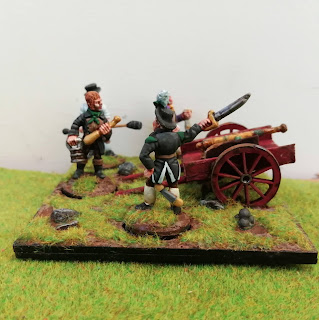After completing the French, I still had a few extra models. I decided to paint them up, finishing off the Lead Mountain in the process!
The first piece I made is a French Deployment Point. These are among my favourite things to paint for Sharp Practice, as I can make little scenes. I like painting leaders for the same reason.
Capitane Garnier discusses revolution with Cuan. Kilalla Bay, August 1798.
The beach was built up with Milliput. The sand is painted snow flock.
The water was painted straight onto the MDF base. I used gloss varnish on top.
The flagpole is a wire pike. The Phrygian cap was added with Milliput.
Next, I painted up another Leader for my United Irish army. I plan on painting every Irish personality that Trent produce - this will give me greater freedom to represent the different theatres of the rebellion.
This is Joseph Holt, a leader of United Men in County Wicklow. Holt was from a Protestant, Loyalist family near Redcross. He was as a farmer, but also worked as a sub-constable, fugitive hunter and a fabric inspector! Holt's Memoirs contain exciting stories about his pursuit of criminals, all told with great relish. In his own words, "my name was to the disobeyors of justice a terror"!
Joseph Holt led a guerilla campaign against British troops, making use of the Wicklow Mountains. After the defeat at Ballinamuck, the rebels had lost all hope of success. Holt surrendered, and was transported to New South Wales. His fellow Wicklow Captain Michael Dwyer continued the campaign until 1803(!). Holt was pardoned and left Australia for Ireland in late 1812. However, his ship struck a reef. He and his family had to land on one of the Falklands. They would not make it to Ireland until 1814.
I can't believe I'd never heard of Joseph Holt before starting to research this period in greater depth. His life story is just so interesting, and I think he's the perfect Sharp Practice character.
There is debate over Holt's reasons for joining the United Irishmen. In his Memoirs, written in Australia, he claims he was swept up by the rebellion. He does, however, sympathise with the rebels' grievances. This isn't a satisfactory answer. Holt had been involved in the Society of United Irishmen since 1797, and several of his brothers were also members. Holt's membership of the Irish Volunteers in the 1780s also suggests a liberal political standpoint.
Holt took up arms after his home was burned by the Fermanagh Militia. This unit was under the command of local magistrate Thomas Hugo. Hugo owed Holt money; as such, his rebel activities may have been the result of personal rivalries.
Many of Holt's men were Militia deserters. I've painted this chap in a mix of Militia and civilian clothing.
Finally, I put together a water cart. In Sharp Practice, these are available as a support option. It's been thrown together from coffee stirrers, cocktail sticks and spare plastic wheels.
The barrels are from a Warhammer fantasy Ogres kit. A lad at my gaming club gave me some spare bits (thank you very much!). The crate and canteen are the result of my dodgy sculpting.
While I'm waiting for some more minis to arrive, I've started making some buildings for this period. One is based on Evoy's Forge, which I visited this summer. I've posted some pictures of that trip here.
Go dtí an chéad uair eile, beir bua!


















































